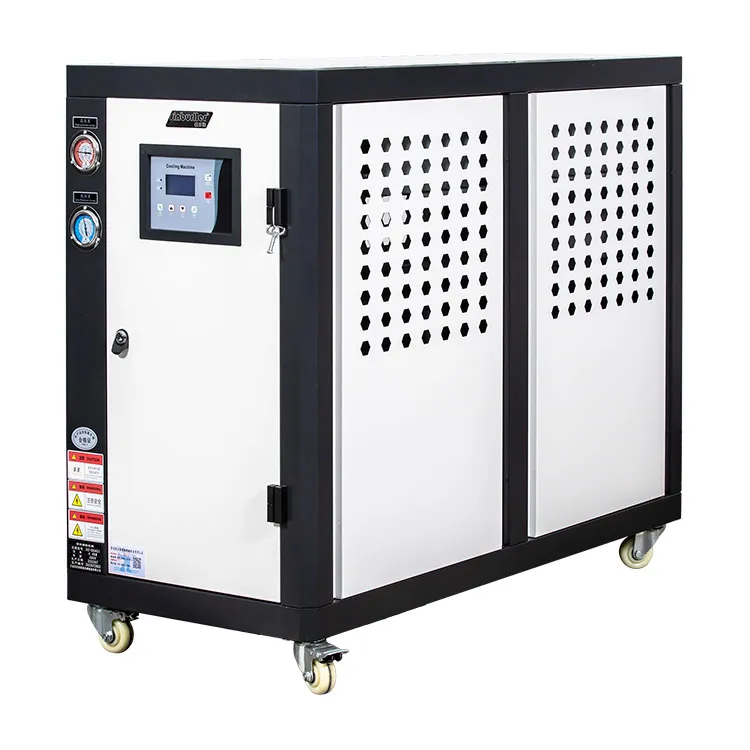What Are Air Cooled Chillers and How Do They Work?
2024-10-12
Air-cooled chillers are refrigeration systems used to remove heat from liquids in industrial, commercial, or residential applications. They rely on air to cool the refrigerant within the system, as opposed to water-cooled chillers that use water. These chillers are typically employed in HVAC systems, industrial cooling processes, or in places where water resources are limited.
How Do Air-Cooled Chillers Work?
Air-cooled chillers operate on a refrigeration cycle that transfers heat from a liquid (typically water or a water-glycol mixture) to the air. The process involves four key stages:
1. Evaporation (Absorbing Heat)
- Evaporator: The liquid to be cooled (e.g., water) is passed through the evaporator, where it exchanges heat with the refrigerant. As the refrigerant absorbs the heat, it evaporates, changing from a liquid to a gas.
- Heat Absorption: The now-cooled liquid (e.g., water) is then circulated through the system to cool equipment, buildings, or industrial processes.
2. Compression (Increasing Pressure)
- Compressor: The refrigerant gas that has absorbed heat is compressed in the compressor, increasing its pressure and temperature. This step is crucial because it prepares the refrigerant for efficient heat rejection.
- Pressurization: The high-pressure refrigerant moves to the next stage, where it can release the absorbed heat.
3. Condensation (Releasing Heat)
- Condenser Coils: The hot, pressurized refrigerant passes through the condenser, which is equipped with air-cooled coils and fans. These fans draw ambient air over the coils, allowing the refrigerant to transfer its heat to the air.
- Cooling Process: As the refrigerant releases heat to the air, it cools and condenses back into a liquid.
4. Expansion (Lowering Pressure)
- Expansion Valve: The cooled liquid refrigerant passes through an expansion valve, where its pressure is reduced. This drop in pressure causes the refrigerant to cool further, preparing it for another cycle of heat absorption in the evaporator.
The cycle repeats, continuously absorbing heat from the liquid to be cooled and releasing it into the surrounding air. The chilled liquid is then circulated through the system for cooling purposes, while the hot air generated during the process is exhausted outside.

Key Components of Air-Cooled Chillers
1. Evaporator: Transfers heat from the water or process liquid to the refrigerant.
2. Compressor: Pressurizes the refrigerant to prepare it for heat rejection.
3. Condenser: Cools the refrigerant by transferring heat to the surrounding air using fans and coils.
4. Expansion Valve: Reduces the pressure of the refrigerant, causing it to cool further before entering the evaporator.
Advantages of Air-Cooled Chillers
1. Water Conservation: Since they rely on air for cooling, air-cooled chillers don't require water, making them ideal for locations with water shortages or restrictions.
2. Lower Maintenance: Compared to water-cooled chillers, air-cooled systems generally require less maintenance because they don’t have cooling towers or water treatment systems.
3. Installation Flexibility: Air-cooled chillers are more versatile and easier to install since they do not require access to a water source or additional piping for water circulation.
4. Suitable for Smaller Systems: They are often more cost-effective for small to mid-sized applications and systems, like in commercial buildings, where large-scale cooling isn't necessary.
Disadvantages of Air-Cooled Chillers
1. Less Efficient: Air-cooled chillers are generally less energy-efficient than water-cooled chillers, particularly in very hot environments, as air is less effective at transferring heat than water.
2. Higher Operating Costs: The lower efficiency of air cooling compared to water cooling can lead to higher electricity consumption and operating costs.
3. Noise Levels: The fans in air-cooled chillers can generate more noise, which might be an issue in certain environments, such as residential areas.
Applications of Air-Cooled Chillers
- HVAC Systems: Used in commercial and residential buildings to provide cooling for air conditioning systems.
- Industrial Processes: Commonly used to cool machinery, equipment, or processes in industries like plastics, food and beverage, and pharmaceuticals.
- Data Centers: Provides cooling for servers and other heat-generating equipment.
- Medical and Laboratory Facilities: Used to maintain temperature-sensitive equipment and processes.
Conclusion
Air-cooled chillers are essential for providing cooling in a variety of settings, particularly when water resources are limited or when installation simplicity is desired. Their operation revolves around a refrigeration cycle that efficiently transfers heat from a liquid to the air, offering a cost-effective and low-maintenance solution for many cooling needs. However, due to their lower efficiency compared to water-cooled chillers, they are more suitable for smaller systems or locations with moderate climate conditions.


